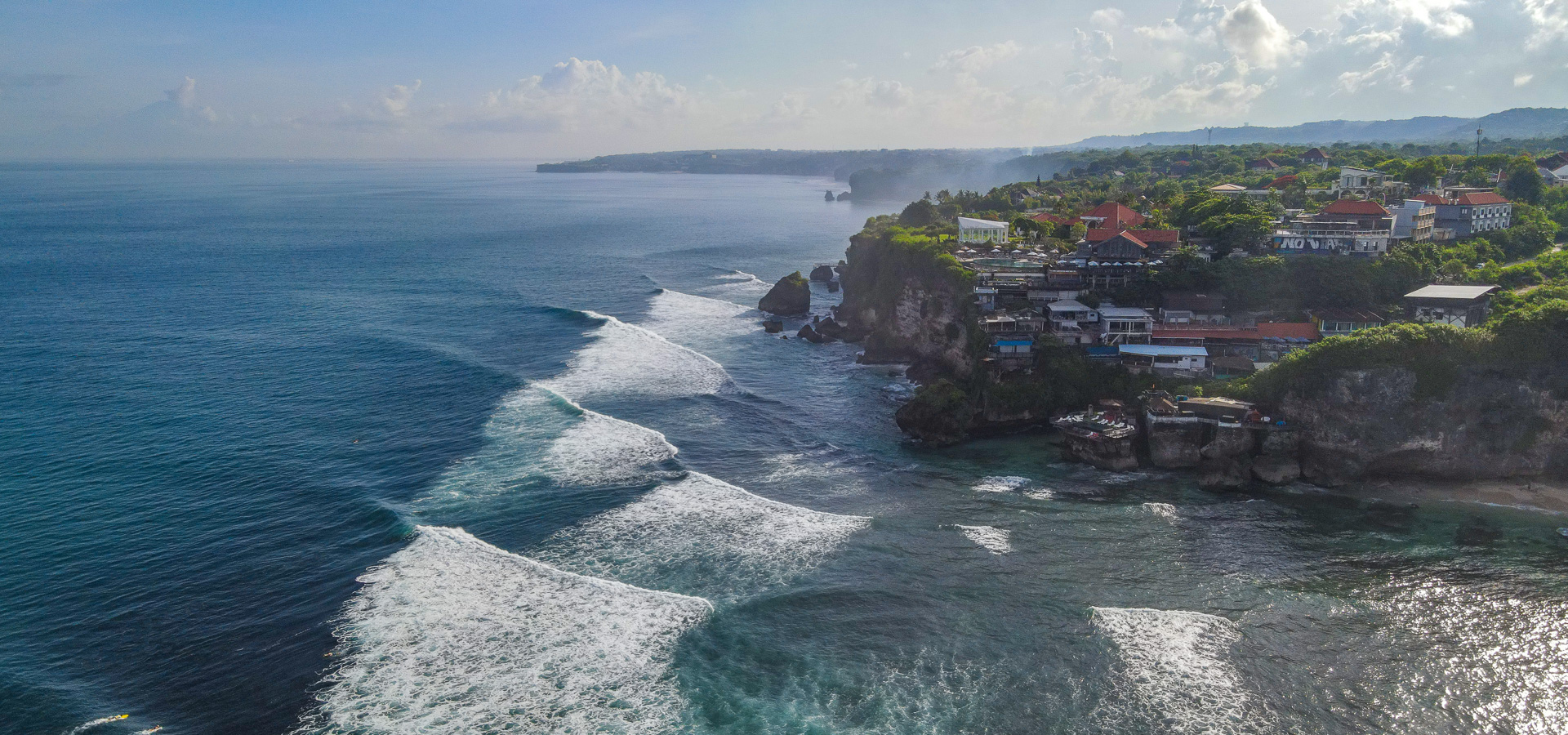
The Complete Guide to Uluwatu Area Surf Spots
Uluwatu is the most consistent surf location in the world.
It’s home to a variety of different waves for all abilities.
All the breaks at Uluwatu are nearby and easily accessible.

Whether you’re a beginner seeking to catch your first wave, an intermediate eager to progress, or an advanced surfer looking for a new challenge, you’ll find it all in Uluwatu.
In total, there are 9 surf spots in the Uluwatu area.
Read on to find out useful information about all the spots in this world-famous surfing destination.
1. Uluwatu
Suluban Beach is commonly referred to as Uluwatu.
Uluwatu is the most famous surf spot in Bali and is known for its consistent and high-performance waves. It’s also the first reef break to be discovered in Bali.
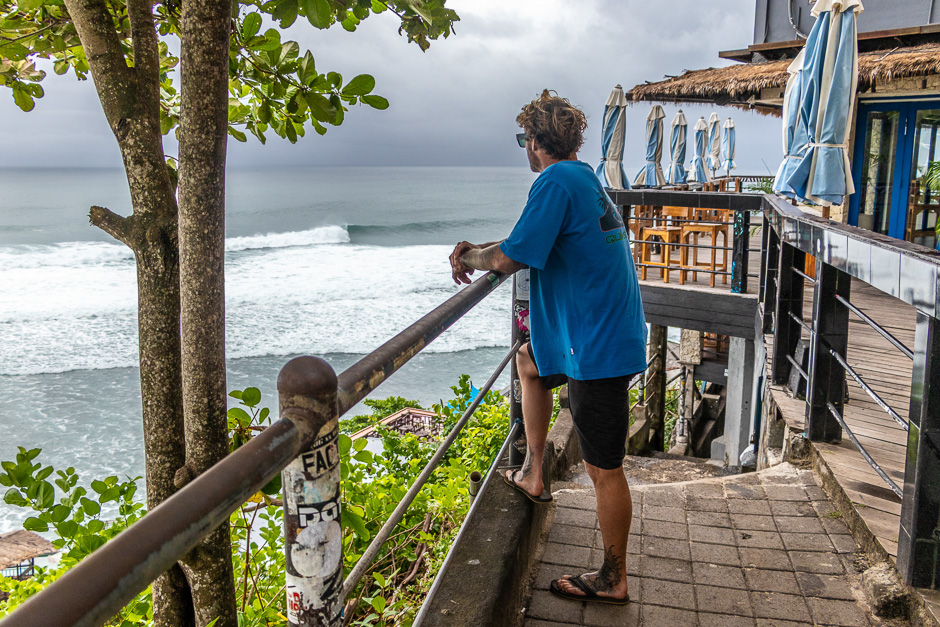
The area has five main peaks for surfing:
- Temples
- The Bombie
- Outside Corner
- The Peak
- Racetrack
Each peak offers different surfing conditions depending on the tides and swell sizes.
Uluwatu attracts top local and traveling surfers. So the crowds and competition can get fierce, particularly when the surf is small.
Uluwatu picks up a lot of swell and it’s never flat because it’s more exposed to the swell than the other breaks further north.
So the waves here are often big and powerful, and we recommend Uluwatu as a surf spot for advanced surfers on a medium to large swell.
Surfing Uluwatu requires caution due to hazards like strong currents, heavy waves, and sharp reefs. And entering and exiting the water at Uluwatu can be difficult, especially on a big day and during high tide.
So make sure you check out our ultimate guide to surfing Uluwatu to learn everything you need to know to master this break.
2. Padang Padang Lefts
Padang Padang Lefts is known as the Balinese Pipeline. It’s one of the most famous and challenging waves on the planet.
The wave here breaks only to the left and needs a big swell to work well. When Padang Padang Lefts is working well, it can throw huge barrels and offers the ride of a lifetime.
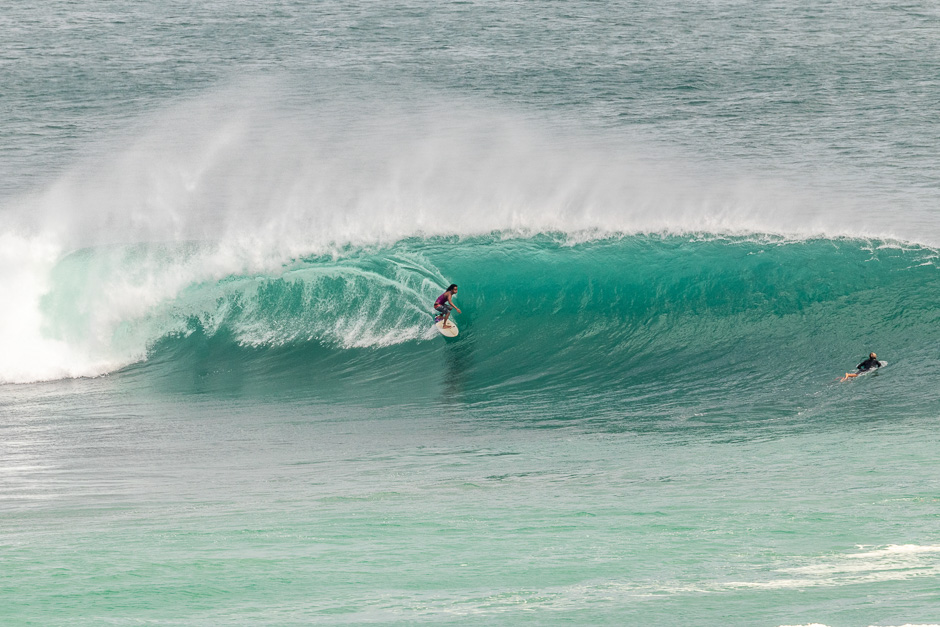
The surf at Padang Padang Lefts is always around 2 feet smaller than at Uluwatu.
You’ll want to surf Padang Padang Lefts when the size is at least a head and a half high, and ideally double overhead and beyond. Any smaller than a head and a half high and the ride is short and the wave quality is poor.
In August, Padang Padang Lefts is home to the Rip Curl Cup, a surfing competition held in August. This competition has featured some of the biggest names in surfing, such as Kelly Slater and Mick Fanning.
There are roughly 25 days a year when the surf is big enough for Padang Padang Lefts to be breaking optimally. When it’s on at Padang Padang Lefts, it’s really on.
Padang Padang Lefts is not a wave for beginner or intermediate surfers.
Are you ready to take on the Balinese pipeline? Read our ultimate guide to surfing Padang Padang Lefts now.
3. Baby Padang
Baby Padang is the lesser-known smaller sibling to Padang Padang Lefts.
Padang Padang Lefts needs a big swell to work. But Baby Padang works well with a much smaller swell.
The wave at Baby Padang breaks both left and right and works best on a small to medium size swell.
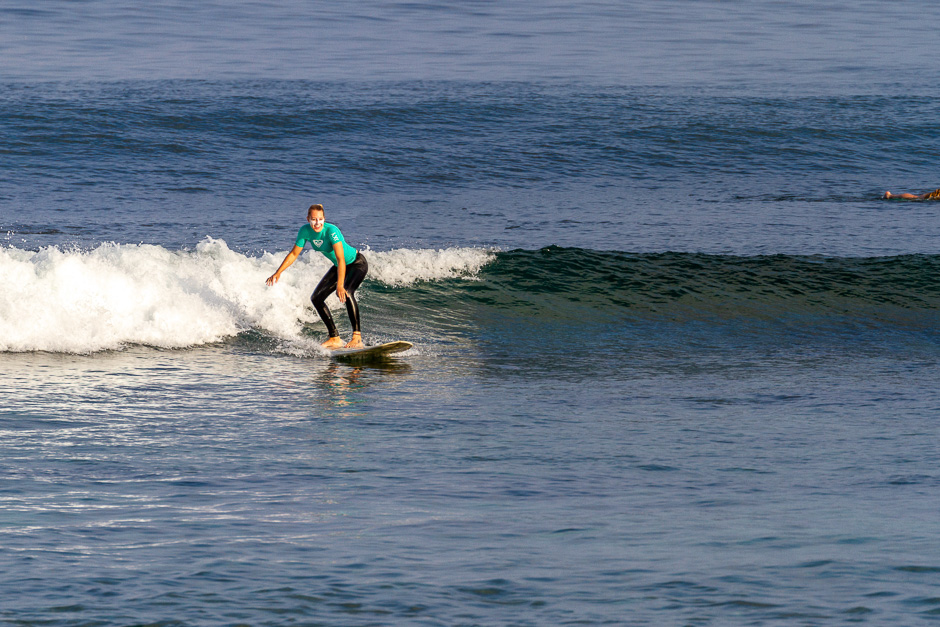
You’ll want to surf Baby Padang on a day when the swell is not much more than head high. When there is a big swell, then the wave breaks too fast and the current becomes very strong.
Baby Padang is one of the best beginner surf spots in Bali and it’s the easiest place to learn to surf in the Uluwatu area.
The waves here are consistent and predictable. You’ll almost always find a wave breaking at Baby Padang.
Baby Padang offers long rides if you’re going left. The rights are shorter, but go directly to the channel and provide an easy paddle back to the line-up.
There are a few dangers to be aware of when surfing Baby Padang. The current in the channel can be strong, so it’s important to be aware of your surroundings and not panic.
Read our ultimate guide to surfing Baby Padang.
4. Impossibles
Impossibles gets its name because the sections break very fast, and most waves are impossible to make.
Wave selection is the key aspect at Impossibles.
If the line is very long you can forget it. But if the wave is tapering and looks like it will be a short ride, then it could be the longest ride of your life.
Only about 1 in 10 of the waves at impossibles break slow enough to offer a long ride. You only need 2 long rides at Impossibles to make a great session.
Impossibles is a popular destination for advanced surfers, particularly on a big swell.
Unlike other surf spots in Bali, there is no current out the back of Impossibles. You need to be patient and wait for the right wave, and you can do so without the stress of paddling against a current.
There are 3 separate peaks at Impossibles, and on the right day the sections can link up and you can get a ride all the way to Bingin.

On very big days it can be difficult to paddle out at Impossibles.
On the biggest days, the easiest entry is from the deep water channel at Padang Padang, and it’s only 100 meters from Baby Padang to the first peak of Impossibles.
Many people paddle out from Bingin. But it’s not the most efficient way, as the current on the inside is pushing you the wrong way.
Here’s our full guide to surfing Impossibles.
5. Bingin
Bingin is a short but intense left-hand breaking wave.
It’s the easiest surf spot in Bali to get barrelled due to the consistency and predictability of the wave.
Take off, slow down, pull in, and get barrelled. Easy except you got to deal with the crowds of hot locals and traveling surfers who are also seeking that barrel.
Bingin never closes out, and there is always an exit from the barrel.
Do you want to get the barrel of your life at Bingin? Get barrel riding coaching from expert instructors in Bali.
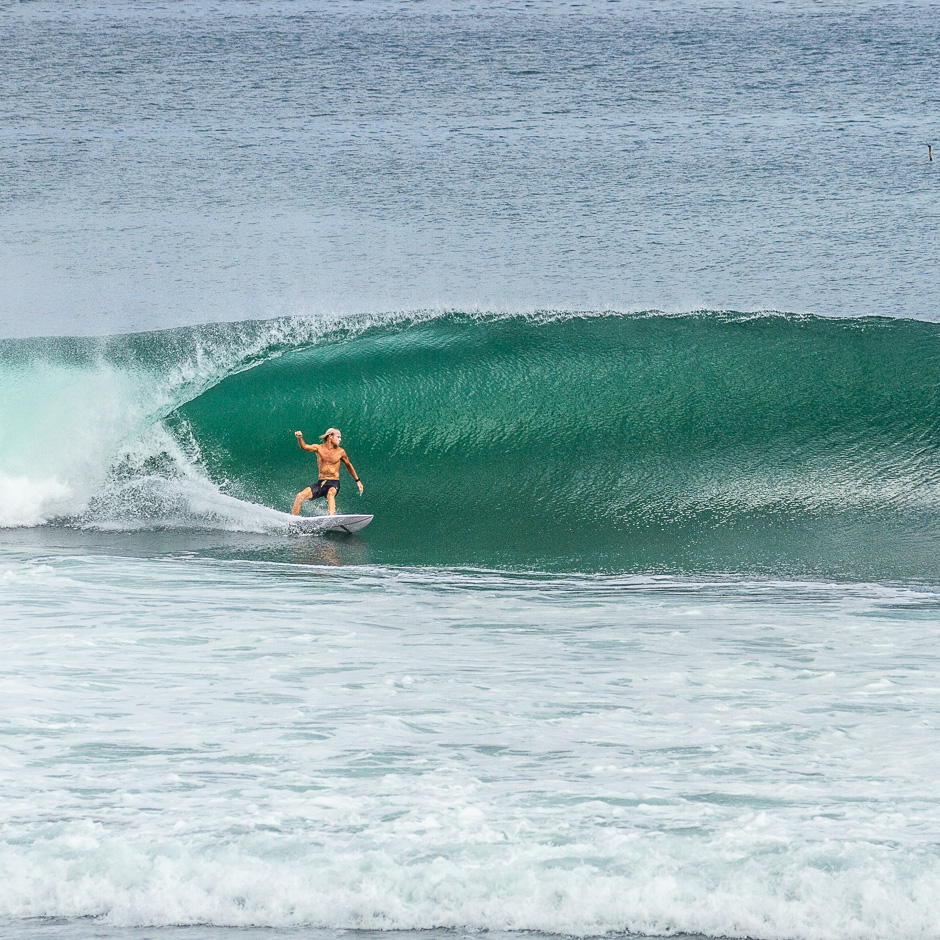
When the conditions are right, Bingin is the most perfect machine-type wave in Bali. Its only fault is the shortness of the ride, but the power more than makes up for that.
It can get crowded at Bingin and the local surfers here have mastered this spot.
Many local surfers will only surf at Bingin because it’s so perfect, and not worth the short ride up to Uluwatu or any other nearby spot in the region.
So if you decide to surf Bingin, then it’s important to be respectful and patient. Eventually, you’ll get a turn to ride this perfect wave.
Be careful not to ride the wave at Bingin too long or you’ll end up in “Greedies”.
Greedies is a section of the wave that breaks over very shallow water and can result in an unpleasant experience. Visiting pros who pull floaters here soon regret it as the wave breaks on dry reef.
Read our ultimate guide to surfing Bingin
6. Dreamland
Dreamland offers a variety of waves that can cater to surfers at different levels, depending on the conditions.
Dreamland is the only beach break with a sandy bottom in the Uluwatu region. This can be appealing to beginners that are weary of surfing at breaks with reefs beneath the waves. But beware, there are hazards such as rocks on the inside of Dreamland.
There are a few different sections of Dreamland.
An A-frame wave with a short right-hander and a fast left-hander that can produce barrels. The wave breaks over flat rock at low tide. This is a premium-quality wave.

When there’s a medium size swell at Dreamland A-frame, then you get softer waves. It doesn’t really break on a small swell because the water is too deep.
As the swell gets bigger, Dreamland can start barrelling at a size of roughly double overhead. Triple overhead is the real deal board snapping Hawaiian-sized barrels and hold downs
South of the A-frame is a left-hand breaking wave that works best on a higher tide and is ideal for intermediate surfers.
Beware of the reform shore break wave on the inside. This spot is popular with locals. But it packs a punch and can easily knock an unassuming surfer off their feet. The local groms love it here as they can pull aerials and get barrelled.
Check out our Ultimate Guide to Surfing Dreamland!
7. Balangan
Balangan is a long reef break with many sections, which can help to break up the crowds.
You can get the ride of your life at Balangan all the way from the headland to the end of the warungs.

You can surf Balangan on all tides. But beginner surfers are advised to only surf here when the swell is small and at high tide.
Balangan is a consistent wave that breaks fast and can be challenging for novice surfers.
The optimal conditions for Balangan are on a bigger swell at high tide.
But it’s also suitable for intermediates on medium days, and beginners when it’s very small.
Discover everything you need to know about surfing Balangan here.
8. Nyang Nyang
Nyang Nyang is a beautiful and secluded beach with great waves. It’s a good spot for intermediate and advanced surfers.
The waves at Nyang Nyang break predominantly to the right, which makes it unique from the usual left-handers in the Uluwatu region.
So Nyang Nyang can be a welcome spot for regular-footed surfers that stand with their left foot forward looking to finally surf front hand.

Goofy-footed surfers that ride with their right foot forward can practice their backhand surfing skills.
Nyang Nyang is south facing and picks up the most swell in the Uluwatu region.
On most days, it’s too big to surf Nyang Nyang.
9. Thomas Beach
The final surf spot in the Uluwatu region that we’ll cover is Thomas Beach, named after a homestay located above the middle of the beach.
Thomas Beach is beautiful and access has been improved recently.
It’s a beautiful beach and access has been much improved recently.
If you want to surf uncrowded waves in the Uluwatu area, then Thomas Beach is the place to go. Thomas Beach has a left-hander that breaks at mid-high tide which is average quality, but a very strong current that deters the crowds.

The only time you will see many surfers at Thomas Beach is at high tide when Uluwatu is massive.
Surfers unable to exit Uluwatu via the cave due to the strong current will come down to Thomas Beach for an easy exit, and then do the walk of shame back to Uluwatu to collect their motorbike.
When is the best time to surf in Uluwatu?
The best time to surf the west coast of the Uluwatu region is during the dry season (April to October). During the dry season, the winds are offshore and this creates optimal surfing conditions.
Nyang Nyang is the exception for winds.
You could still visit Uluwatu during the wet season. The surf spots in Uluwatu can still be very good in the wet season, and will always have a lighter crowd.
If it’s an El Nino year, then the wet season tends to be quite dry. But La Nina is much wetter.
In an El Nino year, there is not much difference between the wet season and the dry season, except the swells are predominantly smaller.
The swells in the wet season are generally smaller compared to the dry season, so this is a good time for beginner and intermediate surfers looking for smaller waves.
Conclusion
The Uluwatu region of Bali is the world’s premier surfing location. The surrounding area of around 5 miles is also referred to as Uluwatu.
This small area on the southwestern tip of the Bukut peninsula is the world’s premier surfing location due to its consistency, quality, and variety.
Uluwatu means lands end, and you’ll find more to do here than just surf. Here you’ll find the most spectacular temple, culture, beautiful beaches, consistent swells, and a variety of surf spots to suit all levels.
From the pumping barrels of Padang Padang to the beginner-friendly Baby Padang, the Uluwatu region presents something for all surfers in close proximity to each other.
So whether you’re seeking the thrill of a big barrel or looking to learn at a more mellow break, you’ll find it all at Uluwatu.
Are you ready to fully embrace Uluwatu’s surf scene?
We invite you to join our surf camp and surf school.
Our expert team of surf instructors and guides will take you to the best surf spot each day, according to the conditions and your individual skill level.
You’ll find the support and guidance you need to ensure your perfect surfing holiday.
To start your surfing adventure, book your stay with our surf camp and surf school today and get ready to experience the joy that Uluwatu has to offer.
See you in the lineup.